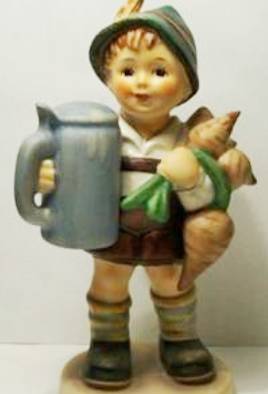
“For Dad” (A “Hummel” by Goebel.)
“Lids on beer steins; why? (Or they must have been very smart flies!”)
Pictured is a young German girl who has been dispatched, out into the cold and snow to get someone in her family, probably ‘old pops’, a maas (liter) of ‘bier.’ (O/O/C: by N. B. Piglhein, author’s collection)
Perhaps the most glaring misconception that is still being promoted in stein collecting, not only by stein book authors but also by the SCI web site itself, and other web sites related to collecting steins, such as some that wish to sell new steins and need “a hook”, is the “MYTH” or “URBAN LEDGEND” of how the lids on German beer steins originated. (Check it out on “Google’ = “Why lids on beer steins” and you’ll get some of these dealers that have just regurgitated this misinformation for years! You should also get this page.)
They continue do this with not one credible “fact” being published, ever!
So what started out to be an answer to a quiz given to the members of the Carolina Steiners in November of 2001 is now a full blown article (some might say, almost a book) I guess like everyone else, I bought “The Stein Book” [by Kirsner and Gruhl, published in 1984], with later additions available now, for the photos and associated prices on the depicted beer steins. It wasn’t until later that I had an occasion to read what had been written about the origin of beer steins. [1]
Quoted from the very first page of a later edition [but the same as the earlier version] called The Beer Stein Book, hereinafter called: “TBSB”:
“From about 1340 until 1380, a bubonic plaque or”The Black Death”, killed more than 25 million Europeans! And of interest here, it is also responsible for the origin of the beer stein. During the summers of the late 1400 hoards of little flies frequently invaded central Europe.”
(One major “editorial correction” by this author that is very much needed here: The “Black Death” which hit southern Europe in 1346 had reached Scandinavia and Russia by 1353. This disease had run its course in 97% of present day Germany by the end of 1350.(2) Now while this first mistake by the book authors, is only a 30 year one, keeping track of the years quoted becomes critical in this, a time related article.
Then this is written, “By the early 1500’s several principalities in what is now Germany had passed laws requiring that all food and beverage containers be covered to protect consumers against these dirty insects…
This covered container law {CCL} and several other public health laws were enthusiastically passed and vigilantly enforced as a result of public fears about a return of the Black Death.” (Note: here again the book’s author/s tosses years of time, now over a century of time around, as if it was only one or two years.)
With the addition of those two statements the authors managed to jump-start the Steve Smith logic machine. I said to myself: “Self, why would anyone wait to pass a law 130 plus years after something happened to try to keep it from happening again?” To put this in perspective, it would as if the USA waited until the year 2071 to declare war on the Japanese for bombing Pearl Harbor. Or the FAA, after 9-11-01, waiting until 2131 to do something about the security of airplane cockpits. Doesn’t make sense to me. Does it to you? Now I do realize that parts of Europe were hit with the plaque time and time again, but T.B.S.B. authors said the “Black Death” (“Bubonic Plague”) and that has definite dates as indicated above.
BUT, IF WHAT THE BOOK (“TBSB”) SAYS IS TRUE?
The“TBSB” says: “several principalities”
- Principalities implies Princes of the Country; which ones?
- Just the “Principalities”, or do the authors mean the German States?
- Which German State, or unit of one?
- What is the definition of several? More than three? Six?
- The eagle emblematic of the Holy Roman Empire of 1510 shows fifty-six member states, (there were even more principalities, but they didn’t rate being on the emblem). So if we say even six of them issued a “CCL” it would only be 10% of the total and hardly any majority to enforce anything. (3) After the Congress of Vienna in June of 1815 the German states-principalities were reduced to a total of 38. Before that there were over 300!(4)
- What date or dates (assuming several) was the” CCL[s]”? This is never really defined in the book.
- If “several principalities” did this – as quoted in the book – then this would INCREASE the possibility of locating just one extent copy of a “CCL”. But again, none have ever been located.
THE GUILDS
Again I quote the The Beer Stein Book: “Throughout the 1700’s, the Pewter Guilds maintained their tight hold on the covered container law.”
- With all the ‘Guild Laws’ that were published, and handed down over time, and now available in the literature, why don’t we see any references to a “CCL”?
- What if another type metal was used for the lid? e.g., copper-smith’s guild, goldsmith’s (silver) guild; these are different guilds; therefore different rules governed them, even while in the same city, at the same time. Why can’t we find references to a “CCL’ in these other guild’s laws?
- Later in history, pewter-smiths would make and sell lids to the stoneware and glass ‘mug’ manufacturers, and distributors, and while these people would have a vested interest in a “CCL” these were also different guilds with different laws. We hear of no record of any “CCL” here either.
- (With relationship to the bullet just above.) The “Golden Age” of stein production was from approx. 1850 to 1910. Several articles have been published in SCI journals and use this time frame. This is a time when “the Guilds”, while still around in name, were almost non-existent in their influence on commerce in their own communities. Germany (with the ‘Little General’s’ help) did away with their guilds in the early 1800’s by law! The Guilds were an idea gone stale, yet lidded beer steins prospered! If “the Guilds” had had an actual “CCL” in the 1500’s, one could and would expect that time period to be the “Golden Age”. Not 350 years later!
- I have yet to establish a verifiable figure for the estimated population of all the German states in the early 1500’s. It was somewhere about 16 million based on later population figures as published in history books. (Also 18 million in Austria, 1 ¼ million in Switzerland)
I believe it is doubtful that all the pewter guilds, even all of them in Europe, could have had the resources to supply and attached enough pewter lids for just the adult’s drinking vessels, to comply with any “CCL”. It would not have been practical, or economically feasible.
WHO EXACTLY WOULD THE “CCL” BE WRITTEN FOR?
TO WHOM DID IT APPLY?
Brewers? Pub keepers? The General public?
Did it apply only while drinking in pubs?
Or did it apply to drinking while outside only? (As flies enter homes at will) did it apply to drinking in the homes? (So, did the “CCL” Police” raid house like we do today for illegal drugs?) The answers to these questions are not evident in the contemporary literature and may provoke even more questions to the rational thinker.
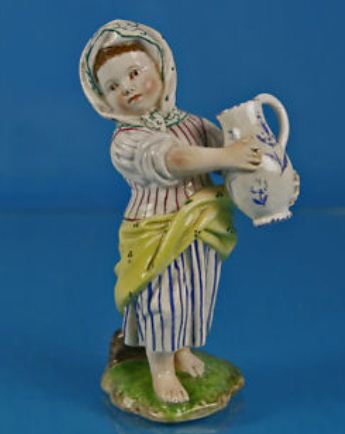
PUNISHMENT
The Beer Stein Book says: “the ‘CCL’ was vigilantly enforced”
- What was the punishment that was decreed by the “CCL”?
- How long was the punishment?
- How many were punished?
- Where did punishments take place?
- Most importantly, who were the “CCL” Police?
- When, (what date/ dates) was the “CCL” repealed?
- Who has a copy or has even seen a copy of any “repealed” law?
OTHER COUNTRIES
- If the origin of the “CCL” was Germany, then why are beer steins then found dated well before the “Early 1500’s” in other country’s artwork: such as England, Ireland, Scotland, The Netherlands, Sweden, Denmark, Poland, Russia, Austria, and even France, whose population has always disdained Germanic ways.
- Did these counties all have “CCL’s” also? Who has seen even one of these? Where published?
For silver steins, it is interesting to quote again from “TBSB” yet again:
“Toward the end of the Baroque period, around 1800, [Ed. Note: please note this date] pewter and silver tankards were still uncommon in Germany. However the English and to some extent the Scandinavians, had by now adopted the finished look of a lidded mug.” [If this was not trying to be a professional article, here is where I’d just say, “Bull Shit!!”, as both sections of this statement are just that! ]
Steins (“covered tankards” = the words used by both the English and Scandinavians) were produced in quantity from the 1500’s and are still seen in abundance in both those counties today. For the Royal’s tankards we can go as far back to the Elizabethan times [1570 to 90’s] in England, finding about a dozen silver covered tankards, with attached lids still existing outside of museums in the USA and England. One can only imagine how many there really were before they got melted down for their silver for its monetary value or using it to produce a more modern piece. (Author’s note: recently auctioned, even while this article was in production, was the “Doyle Tankard”, an English version, hallmarked 1556 and described as: “being copied from the earlier hand made wooden versions”.)
I have also found another interesting reference in an article entitled: “Continental Silver”; “Tankards: appear to have been among the most popular silver vessels made in Northern Europe, especially Scandinavia in the seventeenth and eighteenth centuries” The type that appeared in Germany in the [late] sixteenth century…[that’s late 1500’s folks]… had a small tapering body, but in the next hundred years patterns became larger and more ornate.” (7)
In his book “Drinking Vessels of Bygone Days / From the Neolithic age to the Georgian period,”G.J. Monson-Fitzjohn has this to say: “About the year A.D. 960 wood tankards were in everyday use in all households, large or small, the early specimens being made with small staves held together by hoops of wattle or hide on a solid wood base, the inside being well lined with pitch.”
“These tankards were fitted with wood handles and lids, and were recognized drinking vessels in taverns and inns during the reigns of the last Saxon kings; they were made to hold two quarts of liquor [ale] and the contents were consumed at such a speed that both the State and the Church had to step in. King Edgar [957-975], the son of King Edmund [940-946], was the originator of the idea of decreasing drunkenness by limiting the quantity to be drunk at one time; thus we read that he: “Ordained certain cups with pins or nails set in them , adding thereto a law, that what person drank past the mark at one draught should forfeit a penny, whereof half should fall to the accuser and the other half to the ruler of the town where the offense was done.”
“These vessels became know as “peg” tankards, and were divided into eight sections, each marked off by a peg driven into the wood on the inside of the tankard. The theory was to prevent a member of a company drinking more than his share , or to a point below the next pin, but apparently it did not have much effect… . (Ed. note: again, who would have been the “pin” police?). “…for we read that in later years Archbishop Anselm [Canterbury 1093-1109] found it necessary to inveigh against the practice of over-drinking, also decreeing: “Ut presbyteri non eant ad potations, nec ad pinneas bibant,” which being translated means that priests shall not resort to taverns or banquets, “nor drink to pins”! (8) (Editor’s note: Please see below for further comments by Mr. Monson-Fitzjohn)
SMART FLIES?
- Did the “CCL” apply only to beer vessels? What of wine holders and beakers, mead (which was still very much being made and drunk), milk or water vessels? (Please don’t say the German’s didn’t drink water, as they had about 2,000 mountain spring “ spas” that did an outstanding business – and still do.)
They must have been “awfully smart flies” to only search out only the beer containers while so many other liquids were left unmolested!
Ever watched a fly? Does it land on the liquid? No, it lands on the rim of the container; if it landed on the liquid without flapping its wings it would sink and drown!! Vessel’s rims can be and maybe were sometimes wiped off by the drinker. Some medieval people at that time were aware that flies were associated with waste products of all sorts, but still had no idea about the transmission of germs. And yes, even the foam wouldn’t support an average size fly. Doubt that? Kill one in summertime and then drop it into your beer’s foam; see where it goes – and then go get another beer!
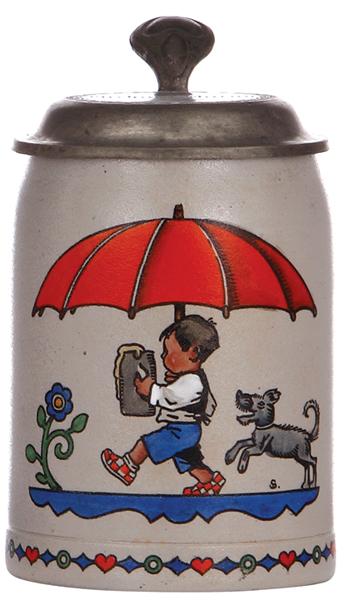
REVIEW OF PERIOD ARTWORK; DATES ON EXISTING VESSELS.
- If a “CCL”, why do we have so many dated beakers, humpens, roemers, etc. from that same time period WITH NO LID still in existence today? While some definitely are, they can’t all be faked or with dates added later.
- If a “CCL”, why do we have a multitude of German oil-on-canvas paintings from that time period that show otherwise?
A review of just one book, the German: Bier, Kunst und Brauchtum, (Beer, Art, and Customs) (5) shows a multitude of paintings with open top drinking vessels on tables, being used. They are all dated during and right after the supposed “CCL” went into affect, using the “early 1500’s” date as published in “TBSB”. Other artwork in other antique books and journals also supports the use of open topped drinking vessels in great abundance throughout that area now called “Germany.”

No lid in sight! Please call the “lid police!” This man needs to go to jail!!
(Now just how stupid is that?)
FOOD
The Beer Stein Book says, “all food and beverages must be covered to protect….” So if it was the law, what ever happened to this part?
- How come we don’t have ALL German tubs, bowls, pots, pans, and plates with a lid attached to cover them?
- Again I would like to make the point, what about wine, ale, mead, milk and water? The quoted “CCL” says “all beverages” does it not?
THE GLASTONBURY TANKARD.
Father along in his book Mr. Monson-Fitzjohn pictures a very nicely carved wooden tankard [beer stein], and includes the following information about it. “What may be considered one of the oldest drinking vessels in England, with a romantic origin, is a Saxon “peg” tankard in the possession of the Lord Arundel of Wardour. It is known as the Glastonbury tankard and is made of oak which has been heavily lacquered, thus preserving the wood to a marvelous extent.” …(here there is a lengthy description of the religious figures carved on the body)…… “and the feet upon which the tankard rest are three couchant lions. Made about 800 years ago and originally belonging to the abbots of the ancient Abbey of Glastonbury, the tankard commenced its life with a halo of romance around it, for legend has it that it had been blessed at the high table in the refectory hall of the great monastery”…. (8) (Editor’s Note No. 1: this book was published in 1927, so minus 800 years means the Glastonbury tankard was made about the 1100’s, or within the 12th century.) The stein shown and billed below as the tankard is just not that old!!
– (Editor’s note # 2) This tankard is shown (by a drawing) on page 521 of PROSIT (SCI’s magazine), Vol. 2, No. 15, September 1995, in the article called “What a Find” by Mrs. Pat Manusov.]
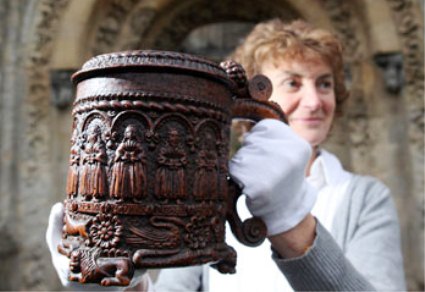
While billed as the “Glastonbury Tankard” on ‘Goggle’ the stein above is much newer. I think the piece shown isno older than the mid to late 1600’s, if that.
NO HELP COMING
Jack Lowenstein, a SCI Master Steinologist, and former Editor of PROSIT, having asked before, asked again for the last time, for any written documentation of a “CCL” in December of 1985 in the PROSIT article: “Once More: Lids on Steins”. Yet to this date, 25 years later, there has not been one piece of evidence has been forthcoming!
BEST QUOTE ON THE SUBJECT
Dee Matthews, a fellow member of the Gambrinus Stein Club (deceased) once said in a discussion of this issue:” Well once the fly got inside, and the lid went down; it would keep the fly in, wouldn’t it?”
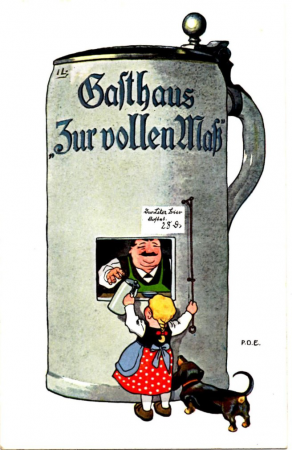
WHAT ALL OF THE ABOVE MEANS TO ME:
[1] If there ever was a “CCL”, which a preponderance of “logical thought” is now against, it was very “local and vocal” and not enforceable to any extent in the area we now call Germany.
2] By covering food and drink, a “CCL”, had it existed in the early 1500’s would have had nothing to do with the development of the beer stein per se, as ‘lidded’ silver and pewter mugs with lids, while already in use, and weren’t popular with the ruling class for many years later.
SO HERE ARE SOME OF THE AUTHOR’S REASONS FOR LIDS ON BEER STEINS -THERE ARE SEVERAL AND THESE ARE NOT PRESENTED IN ANY PRIORITY ORDER. I FURTHER BELIEVE ONE CAN ADVANCE ALL THESE REASONS SIMULTANEOUSLY.
[1] If what Mr. Monson-Fitzjohn says in Drinking Vessels of Bygone Days is true, (and there is no reason to doubt him, as he at least provides us with famous people saying things that can be quoted) England had lidded vessels by the 10th century, and a most famous one, two centuries after. (8) These “English” people at the time were what we now call the “Anglo-Saxons”. This last tribe having come from Saxony. Where was old Saxony located? Germany, of course. So it stands to reason that the custom of wooden lidded steins could have been brought into England far before anyone thought possible. If not brought, then at least copied from the English “Saxons” through trade and family discourse.
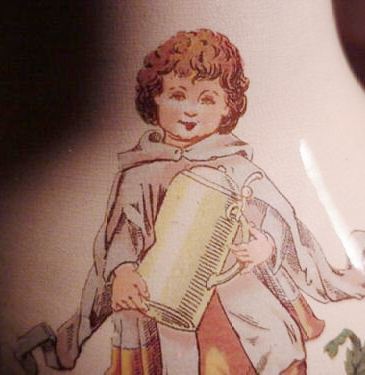
[2] Germany, Scandinavia and England are known as beer, ale and mead drinking counties. By the beginning of the 1400’s, most every town of moderate size had its own brewery, larger towns more than one. Un-pasteurized beer does not keep long, therefore it wasn’t ordered in large holding containers (kegs) and stored in the home except in the very wealthy of places, where it would be used up quickly due to large gatherings. Beer has always been a relatively expensive liquid, (still is by the way! but not as bad as gasoline!)
Beer did not usually come in a small keg like some early wine did. Therefore the family wishing to drink, usually supplied a container for the local brewer to fill. Readers will please review in the book “Bier, Kunst und Brauchtum,”,the beer wagon drivers trying to move the large kegs they were carrying on the early horse drawn beer wagons.
Children, even very young and small ones, were sent to get beer, wine, and food for their dads, moms, and grandparents, and were sent out in all kinds of weather. On the way home if a steak slipped out of the child’s hands and hit the ground they probably would have picked it up. If a corked bottle of wine slips and hits the ground without breaking the person simply picks it up. OH! , but if an “open mug” of beer slips and hits the ground, then: “Oh pooh!” (well you get the idea.)
So lids were added to mugs in Germany, and all other beer drinking countries as well, probably much before the 1500’s to keep the beer from spilling on the child’s, or anyone’s walk back home from the local brewer’s establishment or pub!
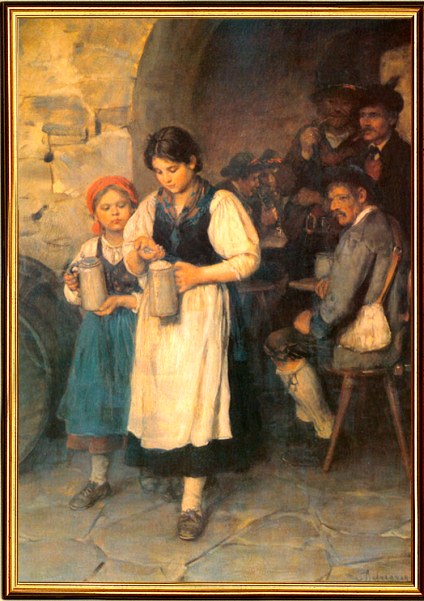
[3] The more I researched the premise behind this article the more I began to believe that lids might have been added to keep something out of the beer, maybe not flies (and its plague) but something! And all I had to do was walk outside one spring morning last year and see all the dried “liquid presents” the doves had left for me on my front porch table. I can almost imagine the old folks (Germans included) while having their festivals, sitting around the trees to keep the sun off them while they were drinking. But the birds would be letting their presence known all the time.
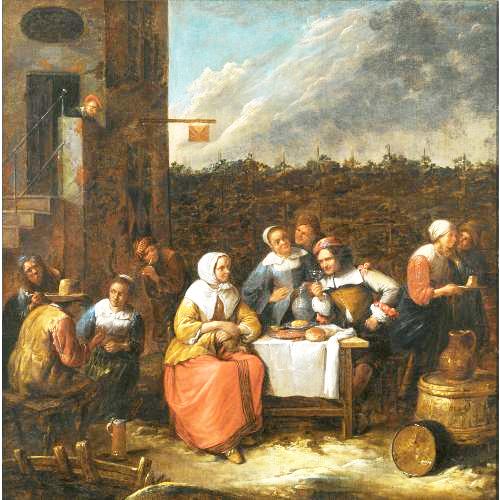
The “deckel” resulted from just being outside and drinking beer.
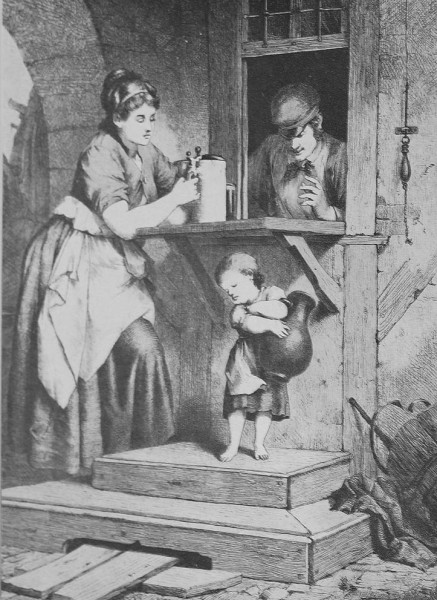
While the server she holds doesn’t have a lid; it does show how easily beer could have been split on the way home. (What a young child, and / or a lazy parent!)
For more information (a great video by Ginger Gehres) on the history behind the lids (which just happens agrees with my take on this subject, but was produced well after I asked the question and wrote my first article which the then editor of Prosit refused to publish) PLEASE view: http://www.steincollectors.org/
then go to “READING ROOM (LIBRARY),”
then click on: “Added Oct 2011: “Why Steins have Lids – An interesting video presentation.”
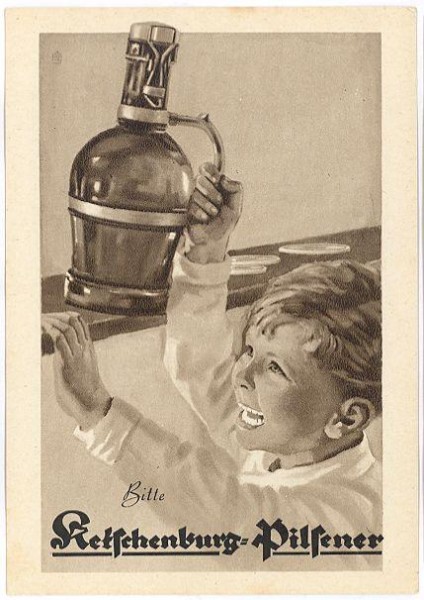
For a brief enjoyable article on lid types, see: http://www.steincollectors.com/steinlids

“You only need two tools in life. WD-40 AND DUCT TAPE!
If it doesn’t move but should, use the WD-40. If it should not move but does, use the duct tape!”

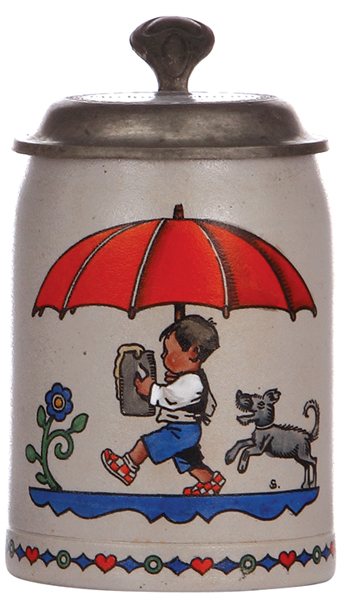
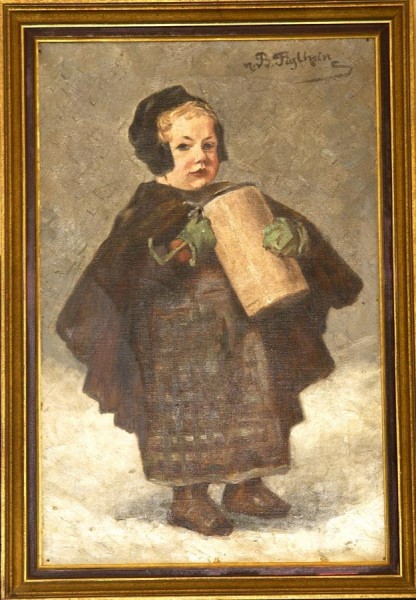
Leave a Reply